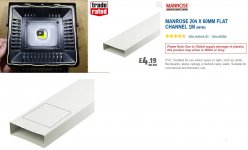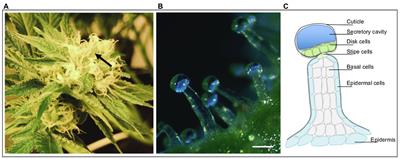Ca++
Well-known member
There are many UVB CFL's around. Most are 5 or 10% but the 12% tends to suppress the uva output a bit more. In ratio terms.
Try to mount horizontally, as it's difficult to reflect. Many papers delve into exotic metal mixes and layering surfaces. They tend to fall back on aluminium, with about 50% reflectivity that rapidly drops with surface contamination.
These kind of things are known as smart cobs, or driverless leds.

The little chips are over-driven in every example I have seen. They are thermally reactive though, so back off on the power to attain the right temperature. In use, a 50w chip might start off at 50w but will drop quite a lot. Let me see..
I grew with some of these next ones, that are driven a little differently. They do make the 50w rated.
Unfortunately, when we see these in floodlights, in our stores, the efficiency stated ranges from 80-100 lumens per watt.
Ultimately, we are buying 50w chips that are 50w if we can recognise them. Giving us 4000 lumens for about $3. Plus the real cost, the heatsink. This, as a package, compares favourably with an e27 domestic lamp in outlay. Only the smart cob uses 50% more power, and you have to make it.
I got involved as I wanted a project. I had my lights looking out through a window cut in some ducting. It was more elegant than it sounds. Honest. Then again when I wanted a spot frequency. That is where these champion. You can specify colours. Beware, testing of the burples has seen numbers like 30 lumens per watt. It's for experimental use. Not viable plant lighting. Many of the designs are very old in our terms.
The last couple of years, these smart chips have been paired with Samsungs on bigger boards. Again the heatsink stops us buying them. With the smart chip efficiency really eating into the light units efficiency. Making a Mars a better option for most. Here is a complete unit, just to see one https://www.aliexpress.com/item/2255800112355797.html
Altitude doesn't just see more UV. The whole spectrum of colours is tipped. As we move from the sun, light attenuation is proportionate to wavelength. The seasonal disorders in people are due to lower blue levels. Down here, the red is getting through better. Up there, the white balance is better, as there is less attenuation of the green, and even less of the blue. For this reason, the better weed at altitude observations shouldn't be thought of as uv. Though it's a sign.
What we have seen is light ratio research where the red and blue rations are looked at. The result that neither should be far ahead of the other. With red able to take a greater lead, but shouldn't be more than 60% of the spectrum, if we don't want to see bleaching at even moderate light levels. These tests tell a story along with altitude. Our plants like a good white balance.
We don't have good white balance in our lights, though some of seen higher CRI as better than more umol. One of the goals to date, has been making the most useful light for the least electricity. Red is easier to make, so LEDs have been leaning heavily on red production to get them umol/j numbers higher. This works until we start using amounts of light on our high value crops, that other crops couldn't expend. As we push, we see the problems with poor white balance. Remember a few years back, we were all burple. Then white mixes. Now we are white with red and blue mixes. Plot out our direction. The very latest research has me about to swap out my panels for one's without extra reds. After my last swap was to get better reds. Crazy. Though the 301 evo isn't for us I don't think. As it moves away from a good white balance. With it's eyes set on leafy greens. It has low red levels that some 660s won't address in terms of even spectral output.
I have one thorn in my side. Our microgrows section. The comparisons thread. People liked warm white over cool white. I suspect the cool whites used red doping that wasn't as red as that in the warms. That is if could see the spectrum of each, we wouldn't just see less of the same red, but actually a shift of the red peak towards a shorter wavelength. It's the only way my mental image of whats happening can work. Which is an image of the sun being a good measure to replicate, as plants evolved to use it. Though I don't buy into the UV story, which I have run on 3 occasions. A 4th I put a plant under just UV-C, no other lighting. They can see it. I just haven't found it useful. Actually... I have not run uv-b since going LED. Now I just read the reports of the big players, which is the best thing about legalisation. Though some things you still have to do yourself.
Try to mount horizontally, as it's difficult to reflect. Many papers delve into exotic metal mixes and layering surfaces. They tend to fall back on aluminium, with about 50% reflectivity that rapidly drops with surface contamination.
These kind of things are known as smart cobs, or driverless leds.
The little chips are over-driven in every example I have seen. They are thermally reactive though, so back off on the power to attain the right temperature. In use, a 50w chip might start off at 50w but will drop quite a lot. Let me see..
I grew with some of these next ones, that are driven a little differently. They do make the 50w rated.
Unfortunately, when we see these in floodlights, in our stores, the efficiency stated ranges from 80-100 lumens per watt.
Ultimately, we are buying 50w chips that are 50w if we can recognise them. Giving us 4000 lumens for about $3. Plus the real cost, the heatsink. This, as a package, compares favourably with an e27 domestic lamp in outlay. Only the smart cob uses 50% more power, and you have to make it.
I got involved as I wanted a project. I had my lights looking out through a window cut in some ducting. It was more elegant than it sounds. Honest. Then again when I wanted a spot frequency. That is where these champion. You can specify colours. Beware, testing of the burples has seen numbers like 30 lumens per watt. It's for experimental use. Not viable plant lighting. Many of the designs are very old in our terms.
The last couple of years, these smart chips have been paired with Samsungs on bigger boards. Again the heatsink stops us buying them. With the smart chip efficiency really eating into the light units efficiency. Making a Mars a better option for most. Here is a complete unit, just to see one https://www.aliexpress.com/item/2255800112355797.html
Altitude doesn't just see more UV. The whole spectrum of colours is tipped. As we move from the sun, light attenuation is proportionate to wavelength. The seasonal disorders in people are due to lower blue levels. Down here, the red is getting through better. Up there, the white balance is better, as there is less attenuation of the green, and even less of the blue. For this reason, the better weed at altitude observations shouldn't be thought of as uv. Though it's a sign.
What we have seen is light ratio research where the red and blue rations are looked at. The result that neither should be far ahead of the other. With red able to take a greater lead, but shouldn't be more than 60% of the spectrum, if we don't want to see bleaching at even moderate light levels. These tests tell a story along with altitude. Our plants like a good white balance.
We don't have good white balance in our lights, though some of seen higher CRI as better than more umol. One of the goals to date, has been making the most useful light for the least electricity. Red is easier to make, so LEDs have been leaning heavily on red production to get them umol/j numbers higher. This works until we start using amounts of light on our high value crops, that other crops couldn't expend. As we push, we see the problems with poor white balance. Remember a few years back, we were all burple. Then white mixes. Now we are white with red and blue mixes. Plot out our direction. The very latest research has me about to swap out my panels for one's without extra reds. After my last swap was to get better reds. Crazy. Though the 301 evo isn't for us I don't think. As it moves away from a good white balance. With it's eyes set on leafy greens. It has low red levels that some 660s won't address in terms of even spectral output.
I have one thorn in my side. Our microgrows section. The comparisons thread. People liked warm white over cool white. I suspect the cool whites used red doping that wasn't as red as that in the warms. That is if could see the spectrum of each, we wouldn't just see less of the same red, but actually a shift of the red peak towards a shorter wavelength. It's the only way my mental image of whats happening can work. Which is an image of the sun being a good measure to replicate, as plants evolved to use it. Though I don't buy into the UV story, which I have run on 3 occasions. A 4th I put a plant under just UV-C, no other lighting. They can see it. I just haven't found it useful. Actually... I have not run uv-b since going LED. Now I just read the reports of the big players, which is the best thing about legalisation. Though some things you still have to do yourself.





